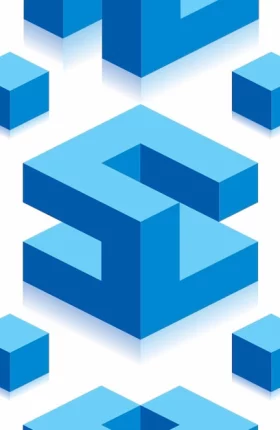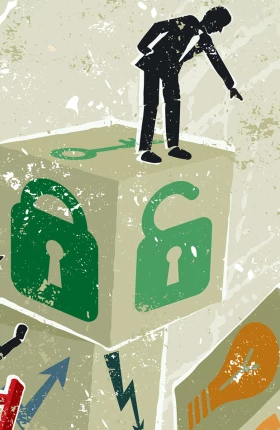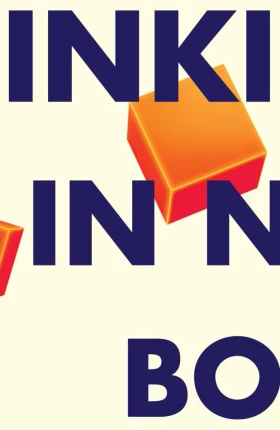We’ve all sat in brainstorming sessions that felt painful and meandering, with no meaningful outcome. But if done right, brainstorming can lead to true creative breakthroughs. If you’re reading this article, then you likely believe, as we do, that effective brainstorming skills can be practiced and developed—for example, the ability to ask the right question(s) and to Building New Boxes: How to Run Brainstorming Sessions That Work, which can “nudge” people to think in novel ways. The assumptions and biases that lock us into old ways of thinking are among the biggest obstacles to creativity. Studies indicate that context and environment—such as group norms and pressures that employees aren’t even conscious of—influence people’s emotions, beliefs, and behaviors. These barriers can get in the way of effective brainstorming.
The assumptions and biases that lock us into old ways of thinking are among the biggest obstacles to creativity.
In this article, we draw on insights from behavioral economics—a field that combines psychology and economics—to offer advanced techniques or “nudges” for getting people to think and act differently. (For a primer in basic brainstorming, see “Brainstorming 101.”)
Brainstorming 101
Brainstorming 101
Effective brainstorming begins with the right environment. Create a judgment-free zone, for the sake of the rare occasions when our instinctive “that’ll never work” reaction is wrong. Have the session away from the daily routine, and include a wide range of people and viewpoints. A skilled facilitator is also critical to success. The best sessions have a leader who is well-trained, alert, flexible, and prepared with techniques to keep the energy—and the ideas—flowing.
The typical brainstorming session includes five steps. (See the Exhibit.)
As co-authors and friends who appreciate each other’s passions, we enjoy working together because we believe that our two fields—creativity and behavioral economics—complement each other. By combining this knowledge with our experience and observations from the field, we’ve distilled five guidelines for taking your ideation sessions to the next level:
Get the Right People in the Room—and Make Them Feel Honored to Be There
To ensure a wide range of perspectives, try to curate a group that is as diverse as possible in terms of work experience, academic background, seniority, gender, function, time with the organization, and other factors. Also, you’ll want to do what you can to help people arrive in a positive frame of mind, confident that they can add something of value to the session. Since most people like to think of themselves as creative—or at least as having special knowledge, insights, or expertise—let them know that senior leadership has hand-picked them for this exercise, whether because of their creativity or experience, or because they’re viewed as one of the “next generation” of leaders. When people feel valued for their creativity and insight, they’re more likely to display those precise qualities.
Once you’ve brought everyone together, you can do a few more things to open the floodgates of creativity in the brainstorming session. One is to use the power of suggestion: simply remind people that groups like theirs often generate hundreds of ideas during the exercises they’re about to do. You can also share stories about the habits of famously creative people, such as Mozart or da Vinci. When stuck, such geniuses were known to shake things up with a change of scenery or by looking at a problem from an opposite perspective. By using such techniques to shift people’s “identity salience”—how they self-identify and present themselves in a specific situation—we can begin to offset the cognitive biases that get in the way of creative breakthroughs.
Create a Safe Place for Radical Ideas
Once a range of new ideas has been generated, the naysayers of the group often emerge. And the truth is, virtually any idea can be found lacking in a worst-case scenario. Too often, however, this type of outlying, exceptional case becomes the justification for maintaining the status quo. Other times, deeply hidden, irrational, or irrelevant agendas can block progress. We worked with the manager of a business unit who steadfastly refused to cooperate with another unit. We finally discovered why: Someone from that unit had denied him permission to use their phone some 30 years earlier.
To overcome such obstacles, we ask brainstorming teams to set aside practicality and temporarily embrace an extreme, positive outcome. For instance, we might ask them to imagine that it is five years in the future and sales volume has tripled. What specifically did we do this year to get started on that path? Or, imagine that those two feuding business units are now working very well together. What changed? By starting with a stretch goal and exploring what it took to get there, brainstorming teams can let go of biases, assumptions, and knee-jerk “nos”—and move into new territory.
Vote for Radical and Practical Ideas Separately
When we ask participants to vote on the ideas they’ve generated, discomfort with the unknown typically leads them to pick options that seem the most feasible and workable. They will do this even if those ideas were ones the business has tried and failed to execute previously, or initiatives that are already under way. That’s why the smaller, shorter-term initiatives with less complexity usually tend to get a thumbs-up. The more “out there” ideas with a potentially higher payoff are largely ignored, simply because they’re less well-understood, harder to visualize, and seem more risky. This is known as the “ambiguity effect,” in which a lack of information causes people to select options where the path to success is the most familiar.
Discomfort with the unknown typically leads people to pick options that seem the most feasible and workable.
One way we overcome this cognitive bias is by having participants broaden their choices. For example, we might ask people to pick their favorites from two categories: ideas that are “fully baked,” entirely feasible, and ready to go; and ideas that are still cooking but could become the next big thing with a bit more time in the oven. Besides overcoming the human tendency to go with the safest bet, this approach results in a richer, more varied portfolio of options with a wider range of time frames.
Provide Time for Solo Thinking, and Make Sure Everyone Is Heard
In any business meeting, the most senior people or those with the loudest or most assertive voices typically overpower the introverts of the group. In a creative setting, this can mean that some of the best ideas are never heard. To overcome this problem, share the question(s) in advance and ask everyone to come to the meeting with a list of their ideas. You can even set up a private “idea box”—on- or offline—where people can submit ideas but remain anonymous. In the meeting itself, start each exercise with a few minutes of solo thinking before teaming up, then have people share and build on ideas in their groups. When the time comes to vote for ideas, find a way for people to register their choices anonymously through a secret ballot of some sort, or post all the ideas on a board and have people put sticky notes on their favorite(s)—but only after they’ve made their choices alone to minimize “groupthink.”
Share the question(s) in advance and ask everyone to come to the meeting with a list of their ideas.
Have Participants Publicly Commit to Next Steps
The energy, inspiration, and excitement that a good brainstorming session generates can quickly fizzle without a commitment to concrete actions. At the end of every session, we ask participants to specify—out loud and in front of each other—what follow-up step(s) they will take for the top practical ideas as well as the more radical ones. They might commit to doing something relatively simple, such as more research on an idea, talking with a colleague in the sales division, or testing an idea with a customer. Or they might commit to something more substantial, such as hiring a new team or redesigning a process. The follow-up might only be that the organizers will share the list of ideas generated and action steps by a certain date—but whatever it is, this final step is critical because it channels the positive energy of the brainstorming session into productive action. Without such completion and closure, participants might end up feeling they’d just wasted their time and thus become jaded, cynical, and disillusioned.
True creativity is a struggle for most people. Our biases and assumptions tend to keep us from looking at problems with fresh eyes. To succeed, brainstorming must overcome such preexisting mental models and encourage participants to see things differently. The advanced techniques we’ve just outlined are specifically designed to overcome people’s cognitive biases—and propel your brainstorming sessions to a higher level of effectiveness.






